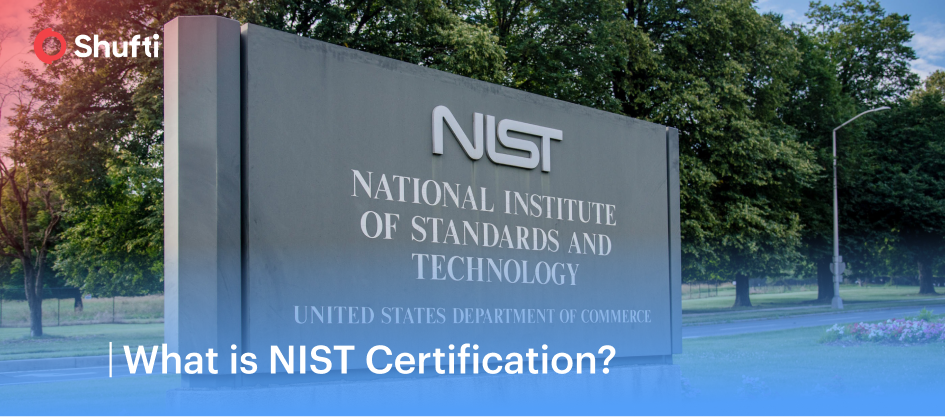What Is NIST Certification and Why Does It Matter in Cybersecurity?

- 01 What is NIST Certification?
- 02 What Are the Core Frameworks and Standards Behind NIST Certification?
- 03 Why Does NIST Certification Exist and Why Is It Important?
- 04 Who Needs to Comply With NIST Standards?
- 05 How does the NIST certification process work?
- 06 What Are the Latest Developments in NIST Compliance?
- 07 Final Thoughts:
In a time when cyberattacks can cripple entire industries and data breaches can ruin reputations of businesses overnight, organizations are under constant pressure to prove their systems are secure. Amid this growing demand for credibility, many businesses turn toward the NIST certification concept.
NIST certification, or alignment with NIST cybersecurity standards, represents a commitment to trusted, federally recognized security practices. It is not merely a badge of compliance but a roadmap for strengthening resilience, protecting sensitive information, and building digital trust in an era where data is currency.
What is NIST Certification?
The National Institute of Standards and Technology (NIST) is a federal agency of the U.S. within the Department of Commerce. NIST is responsible for developing technical standards, security frameworks, and guidelines. The purpose of these frameworks is to facilitate innovation and enhance confidence in the systems that manage and process information.
In cybersecurity, NIST publishes widely recognized standards such as the NIST Cybersecurity Framework (CSF) and the Special Publications (SP 800 series), which form the foundation of several national and corporate cybersecurity programs.
Is there an official NIST Certification?
NIST does not directly certify organizations and individuals, as many people may assume. NIST certification normally means that the concerned form complies with the NIST-mandated framework or standard.
In practice, NIST certification can mean:
- The concerned organization is compliant with NIST standards such as SP 800-171, SP 800-53, or the NIST Cybersecurity Framework.
- The relevant organization has a cryptographic module that has been tested under a NIST-administered program, like the Cryptographic Module Validation Program (CMVP).
Therefore, no organization is NIST certified, but can be certified to NIST standards by accredited third parties or official certification programs.
What Are the Core Frameworks and Standards Behind NIST Certification?
1. NIST SP 800-63 Digital Identity Guidelines
In July 2025, NIST released the final version of SP 800-63 Revision 4, updating its Digital Identity Guidelines to match today’s technology landscape. This version sets new standards for identity proofing, authentication, and federation, focusing on stronger fraud prevention, clearer identity roles, and better protection against deep-fake and injection attacks. It also introduces syncable authenticators like passkeys and subscriber-controlled digital wallets, making digital identity solutions more secure, user-friendly, and aligned with modern NIST certification practices.
2. NIST Cybersecurity Framework (CSF) Certification
The NIST Cybersecurity Framework, also referred to as NIST CSF, provides a systematic framework to address cyber risk by use of six major functions, which include Govern, Identify, Protect, Detect, Respond, and Recover.
It is not a certification itself, but most organizations are subjected to third-party audits as a way of demonstrating that they are aligned with CSF certification. This practice is often termed as NIST CSF certification, although NIST does not independently endorse or certify implementations.
3. NIST SP 800-171
NIST SP 800-171 publication describes the security measures needed to protect CUI (Controlled Unclassified Information) in non-federal systems. It is primarily applicable to contractors of the U.S. Department of Defense or other government agencies.
NIST compliance certification under SP 800-171 is demonstrated when organizations are assessed through internal or external audit and report self-attestation or independent audit reports, respectively.
4. NIST SP 800-53 and SP 800-53B
NIST SP800-53 and SP800-53 B documents define and categorize security and privacy controls for federal information systems. These documentations serve as the foundation for risk management across federal agencies and are often integrated into frameworks like Federal Risk and Management Program (FedRAMP) and Cybersecurity Maturity Model Certification (CMMC).
5. FIPS 140-3 and the CMVP Program
The Federal Information Processing Standard (FIPS) 140-3 governs cryptographic module security. NIST gives cryptographic modules that are used by federal agencies as a test through the Cryptographic Module Validation Program (CMVP).
It is among the few cases when NIST offers an official certificate of validation, not to the organization as a whole, but to the cryptographic module of a specific product.
6. NVLAP – National Voluntary Laboratory Accreditation Program
NVLAP accredits laboratories to ensure that they meet strict testing standards. NVLAP assesses laboratories against the technical and management requirements of the ISO/IEC 17025 standard to certify competence. Laboratories accredited under NVLAP can perform official tests that contribute to NIST validations. This ensures that testing environments are credible and reliable.
Why Does NIST Certification Exist and Why Is It Important?
The NIST frameworks and validation programs were developed to normalize cybersecurity best practices and provide a means for the federal agencies and their contractors to secure information. Their principles have since become the standards of digital security in the world.
Why It Matters for Businesses:
- Regulatory Compliance: NIST standards are mandatory for many U.S. federal contracts, particularly ones that deal with Controlled Unclassified Information (CUI).
- Customer Trust: The evidence of NIST compliance leads to greater credibility in the face of customers and business partners who demand high-quality data protection.
- Risk Management: NIST guidelines assist organizations in the process of identifying, evaluating, and reducing risks systematically.
- Operational Resilience: The frameworks promote ongoing observation and enhancement, which would allow them to react to new threats effectively and quickly.
In short, pursuing NIST compliance certification is not just about meeting rules; it’s about reinforcing a culture of trust and preparedness.
Who Needs to Comply With NIST Standards?
Initially, NIST frameworks were intended to be used by federal agencies in the U.S., although their impact has spread across different industries. Currently, NIST compliance has an impact on various areas:
- Government Contractors: Organizations that deal with federal data or CUI are required to comply with the NIST SP 800-171.
- Technology Vendors: Cryptographic product developers should be FIPS 140-3 validated to be recognized at the federal level.
- Cloud Providers: Cloud providers who seek to expand at the federal level must follow frameworks like FedRAMP, which is based on NIST SP 800-53.
- Private Enterprises: Many organizations adopt the NIST CSF voluntarily to strengthen their security posture and gain competitive trust.
Even outside the United States, NIST’s cybersecurity framework is often used as a global best-practice reference for risk management and regulatory alignment.
How does the NIST certification process work?
Although there is no universal “NIST certification,” there are established paths to demonstrate compliance or validation:
- Identify the Relevant Standard: Determine which NIST framework applies to your organization, CSF, SP 800-171, or FIPS 140-3.
- Conduct a Gap Analysis: Evaluate your current policies, procedures, and technologies against the selected NIST requirements.
- Implement Missing Controls: Address gaps by enhancing cybersecurity measures, documenting processes, and training personnel.
- Perform an Assessment: Use internal assessments or hire accredited third-party auditors to evaluate compliance.
- Maintain Continuous Improvement: NIST frameworks emphasize ongoing monitoring and adaptation rather than one-time compliance.
The output of the NIST Certification process is generally a compliance report or validation listing, depending on the program. Vendors who fall under the framework of CMVP are given an official validation certificate, whereas the contractors, in line with SP 800-171, keep continuous assessment records as an indication of compliance.
What Are the Latest Developments in NIST Compliance?
Cybersecurity is constantly evolving, and NIST is responsible for updating its standards to address the new challenges. Some of the most notable recent developments are:
- Transition to CSF 2.0: The latest edition of the Cybersecurity Framework (CSF 2.0) introduces expanded governance and supply-chain risk management guidance.
- Post-Quantum Cryptography: NIST has adopted a new algorithm called HQC that is built against quantum computing threats, ensuring cryptographic security for the future.
- Zero-Trust Architecture Integration: New NIST publications emphasize verification-based access control rather than traditional perimeter security. This aims to enhance security by assuming no device or user can be trusted implicitly.
These developments reflect a significant shift from static compliance to dynamic, intelligence-driven security programs that evolve alongside threats.
Final Thoughts:
Although the organization does not have a single official NIST certification, however, complying with NIST standards is an indicator of credibility, preparedness, and operational maturity.
Companies that adopt these models send a message to customers, authorities, and collaborators that the concerned firm views cybersecurity as a strategic consideration.
As digital transformation accelerates and threats grow in sophistication, maintaining NIST compliance certification is about safeguarding trust, ensuring continuity, and shaping a resilient digital future.



